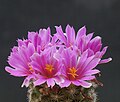Cochemiea boolii
| Cochemiea boolii | |
|---|---|

| |
| Scientific classification | |
| Kingdom: | Plantae |
| Clade: | Tracheophytes |
| Clade: | Angiosperms |
| Clade: | Eudicots |
| Order: | Caryophyllales |
| Family: | Cactaceae |
| Subfamily: | Cactoideae |
| Genus: | Cochemiea |
| Species: | C. boolii
|
| Binomial name | |
| Cochemiea boolii (G.E.Linds.) P.B.Breslin & Majure
| |
| Synonyms | |
| |
Cochemiea boolii is a species of cactus in the subfamily Cactoideae with pink-petaled flowers.
Description
[edit]Cochemiea boolii usually grows singly, rarely the plant branches at the base and then forms small groups. The spherical to short cylindrical, light gray-green shoots reach a height of 3.5 centimeters and a diameter of 3 centimeters. The naked axillae are located between the round warts. The species does not produce milky juice. It also has a natural defense system of thorns protecting the green base of the plant. The single, yellow to yellowish-brown central spine is strongly hooked with a dark tip and up to 20 millimeters long. The white, approximately 20 marginal spines are needle-like, straight and lie close to the body. They reach a length of 15 millimeters.
The pink to lavender-pink flowers are 4 centimeters long and 4 centimeters in diameter. The clubby, orange fruits are up to 30 millimeters long and contain black seeds.[2]
-
Fruits
-
Flowers
-
Spines
Distribution
[edit]Cochemiea boolii is native to the lower elevations of the Mexican state of Sonora and the area around Phoenix, Arizona,[3] found near mostly rocky soils, coastal mountains, and in thin forests and often seen with Echinocereus scopulorum, Echinocereus engelmannii, Mammillaria swinglei, and Ferocactus emoryi.[4] Mammillaria boolii is considered "near threatened" by IUCN and is under threat by urban development.[1]
Taxonomy
[edit]It was first described as Mammillaria boolii in 1953 by George Edmund Lindsay.[5] The specific epithet boolii honors the American Herbert W. Bool, the discoverer of the species and founder of the Botanical Garden in Phoenix. Peter B. Breslin and Lucas C. Majure placed the species in the genus Cochemiea in 2021.[6] Further nomenclature synonyms are Chilita boolii (G.E.Linds.) Buxb. (1954, nom. inval. ICBN article 33.3) and Bartschella boolii (G.E.Linds.) Doweld (2000).
References
[edit]- ^ a b "IUCN Red List of Threatened Species: Mammillaria boolii". Retrieved 2 October 2022.
- ^ Anderson, Edward F.; Eggli, Urs (2005). Das grosse Kakteen-Lexikon (in German). Stuttgart (Hohenheim): Ulmer. p. 373. ISBN 3-8001-4573-1.
- ^ "PlantFiles: Mammillaria".
- ^ "Mammillaria boolii".
- ^ "Cactus and Succulent Journal March-April 1953: Vol 25 Iss 2 : Free Download, Borrow, and Streaming : Internet Archive". Internet Archive. 2023-03-25. Retrieved 2023-11-25.
- ^ Breslin, Peter B.; Wojciechowski, Martin F.; Majure, Lucas C. (2021-02-12). "Molecular phylogeny of the Mammilloid clade (Cactaceae) resolves the monophyly of Mammillaria". Taxon. 70 (2). Wiley: 308–323. doi:10.1002/tax.12451. ISSN 0040-0262. S2CID 233885318.
External links
[edit] Media related to Cochemiea boolii at Wikimedia Commons
Media related to Cochemiea boolii at Wikimedia Commons Data related to Cochemiea boolii at Wikispecies
Data related to Cochemiea boolii at Wikispecies




